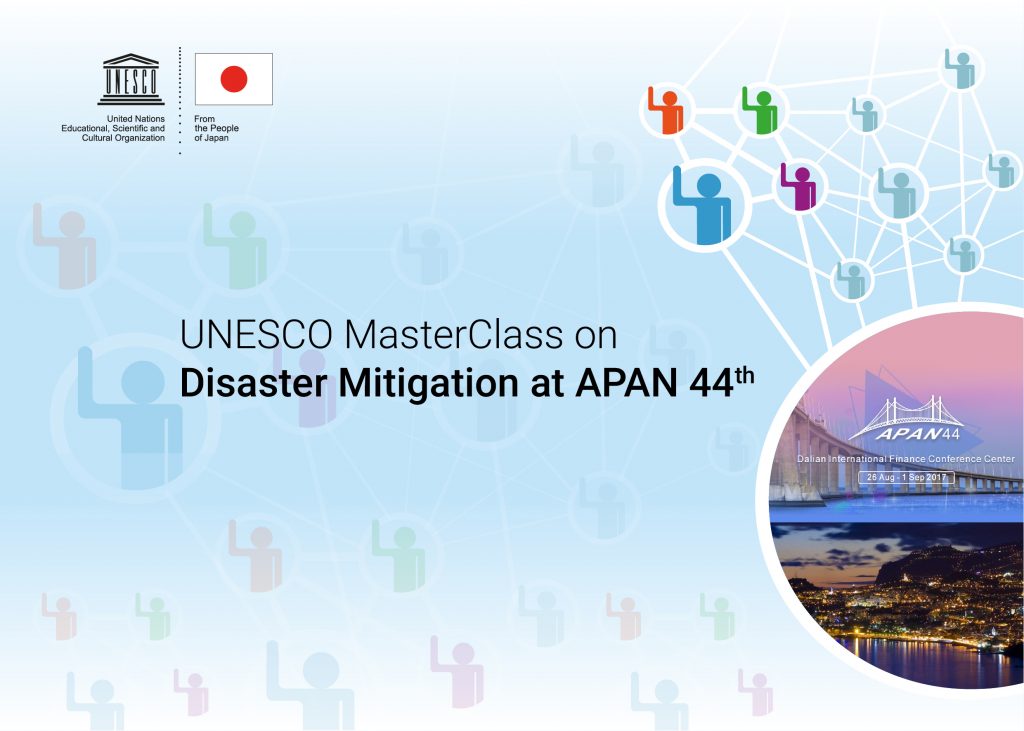Two days workshop with 8 sessions, from 30 August until 31 August 2017. UNESCO is working together with APAN DMWG (Asia Pacific Advance Network – Disaster Mitigation Working Group) for the Masterclass Session at APAN 44th by sharing case studies and promote collaborations through networked open platform in broader types of disasters and geographical coverage in Asia Pacific. Case studies, numerical simulations, simulation facilities, and practices from UNESCO, Disaster Mitigation Competence Centre of EGI-Engage Project and other regional projects will be presented at the Masterclass. APAN DMWG likes to promote more APAN partners to bring use cases, local user communities and requirements. Team building or consultation will be supported from the scientific groups or technology groups coordinated by the Working Group or UNESCO and other sources. Collaboration model, directions and long-term plan will be also bring forward for discussion in the panel session. We also hope the Masterclass is the leading event of a series of Masterclass in the future at APAN meetings
- Session 1: Introduction by APAN DMWG and UNESCO
This session introduced the objectives of disaster mitigation masterclass, which is to strengthening capacity development and collaboration on disaster mitigation by networked open framework in line with Sendai framework for disaster risk reduction and SDG delivery; overview on Disaster Risk Reduction in UNESCO designated sites (MAB, WH); the importance of understanding the disaster mitigation
Lesson learned:
- To always stored all data as most of observation stations are often destroyed after the onset of major disaster events
- To build open collaboration platform for resource sharing
- Session 2 : Numerical Simulation and Sciences of Natural Hazards
This session explained on method for tsunami hazard mitigation with Method of Impact Intensity Analysis (IIA) and the current status of disaster mitigation collaboration.
Lesson learned:
- IIA method that can help us analyzing the potential tsunami sources systemically
- Capacity Building: Develop capacities of natural hazards risk analysis by more accurate and high performance numerical simulations from case studies
- Facilitate Share of Data, Tools, Resource and Knowledge: Buildup the Open Science Platform prototype on Disaster Mitigation to share the data, tools, case studies, services and knowledge
- Extending the Collaboration Network by Training, Dissemination and Support
- Plan for Long-term Collaborations
- Session 3 : Water-disaster Related Initiatives in UNESCO – IFI and IDI
This lesson focused on implementation of a new strategy to reduce flood risk in Asia and the Pacific, with Integrated Water Resources Management (IWRM), the development of satelite based precipitation estimations (Persiann), IOC-UNESCO role in Global Coordination of Tsunami Early Warning and Mitigation System (TEWMS) and the Achievement of the Indian Ocean TEWMS, and Hydroinformatics for Water Management
Lesson learned:
- To develop and improve the hydrological models and methodologies for analysis of flood/drought phenomena
- To support local practice through capacity building
- To develop and apply the Science and technology for agriculture and water resource management
- Session 4 : UNESCO Disaster Risk Reduction Initiatives
This session focused on disaster management in Pakistan by adopting Natural Disaster Management Authority (NDMA), a Visual Inspection for Defining Upgrades Strategy (VISUS) as science based assessment methodology for school safety, and protecting the World Heritage from national hazards through earth observation technology.
Lesson learned:
- By combining mapping and modelling of flood management, it help for flood management stakeholder at every level through web, printed maps, and statistic
- Structural and non-structural improvement are needed as part of flood management
- VISUS: a tool for individuating, managing and controlling the process of actions of risk mitigation
- Disaster risk management for heritage is concerned not only with protecting the property from major hazards but also with reducing underlying vulnerability factors.
- Session 5 : Training on simulation services or more case studies
This session focused on demonstration of tsunami and storm surge modelling by COMCOT Tsunami model. It can demonstrated 2-tsunami modelling: Sumatra tsunami on 2004 and Japan tsunami on 2011. Moreover, 4-storm surge modelling: Haiyan typhoon in Philippines (2013), Soudelor typhoon in Taiwan (2015), Netpark typhoon in Taiwan (2016), Meranti typhoon in Taiwan (2016).
- Session 6 : Case Studies on Storm, Surge, Typhoon, Flood
This session focused on development of fast-calculation storm surge system and case study of 2013 typhoon Haiyan/Yolanda, quality control on observations from the ASTI-developed weather stations, numerical simulations of the December 2014 heavy rainfall event in the east cost of Peninsular Malaysia using Weather Research Forecasting model.
Lesson learned:
- Data quality control is important to make it easier for data users to identify suspicious and errors data and to highlight corrected values
- The Weather Research Forecasting model was able to predict the event considerably well both qualitatively and quantitavely with the right combination of cumulus parametrization.
- Session 7 : Case Studies on Tsunami, Long-distance dust transportation
This session focused on forest fire case study in Indonesia; wildland fire, smoke and haze control in Thailand; disaster and mitigation approaches in urban areas.
Lesson learned:
- The 5-haze protection system such as automated weather station, air quality index, pollution standard index measurements, sensors and sensors network, prediction models, socialize to peoples, appropriate technology for the peoples.
- Six basic steps, Thailand used to deal with forest fires: prevention, monitoring, prediction (forecasting, modelling), warning, response, recovery, assessment, mitigation.
- Human related disaster are getting common in big cities, they could mitigated with the help of state of-the-act technology like IoT, Big Data, etc.
- Session 8: Panel Discussion

